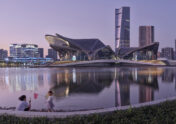
Zaha Hadid Architects Unveils Design Proposals for the Alisher Navoi Centre in Uzbekistan

## Tashkent’s Alisher Navoi International Scientific Centre: A Blend of Tradition and Contemporary Sustainability by Zaha Hadid Architects
Tashkent, the capital of Uzbekistan and the most populous city in Central Asia, proudly showcases layers of historical influence in its architecture. From the elaborate motifs of Islamic artistry to striking Soviet modernism, the city embodies a multifaceted and richly woven cultural identity. This architectural heritage has been creatively interpreted in remarkable new forms by **Zaha Hadid Architects (ZHA)**, whose newest venture — the **Alisher Navoi International Scientific Research Centre** — is set to become a standout feature in Tashkent’s urban landscape. Situated in **New Tashkent**, a rapidly developing district, the innovative center pays homage to Uzbekistan’s illustrious history while looking ahead to an inspiring future.
### A Tribute to Alisher Navoi
Named in honor of **Alisher Navoi**, a celebrated 15th-century poet, linguist, philosopher, and statesman, the center serves as a cultural beacon dedicated to nurturing innovation, education, and scholarly pursuit. Navoi’s impact on literature and philosophy is foundational to Uzbekistan’s cultural identity, and this center stands as a homage to his lasting influence.
Covering an impressive 23,000 square meters (247,570 square feet), the Alisher Navoi Centre artfully captures the grace of traditional Uzbek architecture while seamlessly integrating it with modern design elements. Its arched exteriors, interior passages, and geometric features reflect the fluid architectural syntax found in Tashkent’s **historic mosques**, **medressas** (educational centers), and **mausoleums**. At the same time, its innovative approach to space and materials unveils a contemporary architectural vision.
### Architecture Grounded in Tradition
A key feature of this initiative is its incorporation of **locally-produced bricks**, a timeless resource in Uzbekistan known for its adaptability and eco-friendliness. Historically valued for offering natural insulation and robustness, these bricks are created in Tashkent’s own kilns. The Alisher Navoi Centre reinterprets how these traditional materials harmonize with modernist design, forming a connection between historical craftsmanship and state-of-the-art technology.
The design showcases magnificent, flowing arches — a signature of **Islamic architecture** — that cast a dynamic interplay of light and shadow throughout the structure. These arches are not just aesthetically pleasing; they are also functional, contributing to the building’s environmentally-friendly passive cooling system.
### A Versatile Hub for Culture and Knowledge
The Alisher Navoi International Scientific Centre exceeds the boundaries of a conventional building. Within its arched architecture, it accommodates a variety of facilities that act as venues for education, culture, and research:
1. **Navoi State Museum of Literature**: An expertly curated institution that emphasizes the rich heritage of Uzbek literature, particularly celebrating Navoi’s significant contributions.
2. **400-Seat Auditorium**: Crafted for literary readings, cultural showcases, academic lectures, and international symposiums, the auditorium revitalizes Uzbekistan’s dynamic arts scene.
3. **Residential School for Uzbek Language, Literature, and Music**: A fully immersive educational setting where learners can explore Uzbekistan’s linguistic traditions and classical music legacy, including the revered **Shashmaqom music**.
### Influenced by the Arts: The Essence of Shashmaqom Music
A particularly imaginative aspect of the Alisher Navoi Centre is its connection to **Shashmaqom**, a classical music style rooted in Central Asia. Renowned for its intricate blend of Sufi poetry and delicate instrumental sounds, Shashmaqom embodies elegance and spiritual depth. These attributes are mirrored in the center’s flowing design, which intertwines research areas, performance spaces, and educational zones into a singular harmonious experience.
The architectural rhythm of the centre — with its curves, recurring geometric forms, and open spaces — resonates with the melodic qualities of Shashmaqom, crafting an enveloping environment that represents the melding of culture and art.
### Heritage and Sustainability: A Minimalist Energy Strategy
Going beyond cultural appreciation, the Alisher Navoi Centre champions robust sustainable practices that establish it as a paradigm for eco-friendly development. Zaha Hadid Architects have incorporated advanced **passive cooling systems** into the building’s very structure, ensuring that it remains energy-efficient during Tashkent’s often scorching summers. The system operates as follows:
– **Inner Courtyards**: These beautiful, open-air spaces invite natural light into the interior while acting as social hubs. They also facilitate natural ventilation, lessening reliance on mechanical cooling methods.
– **Hollow Arches with Ventilation Features**: The geometric hollow columns capture breezes and direct refreshing air indoors.
– **Thermal Chimneys**: These innovative features effectively expel warm air while retaining cooler air, leading to lower energy consumption.
– **Locally-Sourced Materials**: By utilizing bricks produced in Tashkent, the centre not only promotes local craftsmanship but also